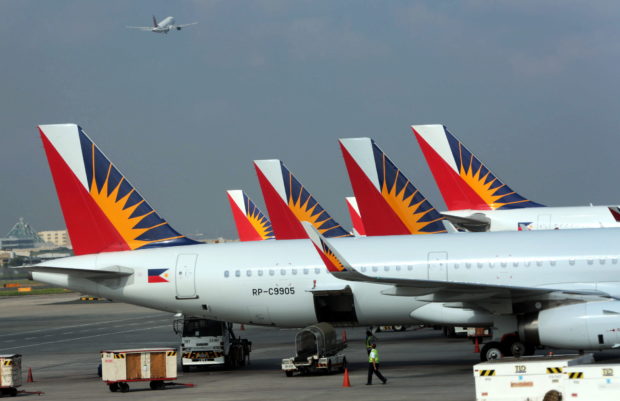Philippine Airlines struggles to survive in pandemic

BANKRUPTCY Philippine Airlines (PAL) filed for bankruptcy to stop further financial losses of its parent company PAL Holdings Inc. amounting to P71.8 billion in 2020. The pandemic struck a devastating blow to the airline after air travel almost grounded to a halt. —GRIG C. MONTEGRANDE
MANILA, Philippines — Philippine Airlines (PAL) formalized an anticipated creditor protection plea in the United States — a move its owner, billionaire Lucio Tan, called a “major breakthrough” in the 80-year-old carrier’s battle to survive the pandemic.
PAL announced on Saturday the filing of a Chapter 11 bankruptcy petition in the Southern District of New York which would pave the way for the elimination of $2.1 billion in aircraft related debts and obligations.
The airline assured the public that flights would not be interrupted and all valid tickets, vouchers, benefits and mileage rewards would be honored.
It also committed to build up its flight operations and continue crucial vaccine deliveries and repatriation flights for stranded Filipinos around the world.
Corporate reorganization
PAL said it intended to maintain business continuity, especially for its employees, customers, suppliers, commercial partners, and local communities. Passenger and cargo flights will continue, subject to travel restrictions, it said.
Once approved by the US court, the petition would protect the airline’s assets, such as planes and equipment from being seized and sold. PAL said it was voluntary and prearranged with creditors and lessors, many of whom were international companies and major local banks.
Chapter 11 of the US Bankruptcy Code is a globally recognized and proven measure for corporate reorganization. It has been used by international carriers, such as Chile’s LATAM Airlines and Colombia’s Avianca.
Fleet reduction, job cuts
Wider in scope than PAL’s rehabilitation program filed in the aftermath of the 1997 Asian financial crisis, the plea is a key piece in a sprawling restructuring plan that requires sizeable fleet cutbacks, debt forgiveness, and billions of pesos in fresh capital.
“We are grateful to our lenders, aviation partners and other creditors for supporting the plan, which empowers PAL to overcome the unprecedented impact of the global pandemic that has significantly disrupted businesses in all sectors, especially aviation and emerge stronger for the long term,” Tan said in a statement on Saturday.
A parallel filing would also be made in the Philippines under the Financial Rehabilitation and Insolvency Act of 2010, PAL said.
PAL will also return 21 planes that were no longer needed for its revised long-term business plan.
It was unclear whether the fleet reduction, representing over 20 percent of PAL’s 95 aircraft, would lead to further job cuts.
The carrier removed 2,300 jobs, or 30 percent of its workforce, last March, joining other airlines that reduced manpower to lower costs given the pandemic-induced slowdown.
Chance for ‘reset’
Aviation and banking sources told the Inquirer these steps would give the flag carrier the opportunity to “reset” and retool its business for the future.
They also agreed the airline’s near-term recovery was dependent on counterpandemic efforts and would test the commitment of the Tan family in supporting PAL through continued losses.
“It all depends on how much financial ‘rope’ Lucio Tan is willing to provide,” Avelino Zapanta, PAL’s president during the carrier’s 1999 rehabilitation, told the Inquirer.
“Even until next year, I don’t see normalization for airlines happening,” he added.
While the global health crisis worsened PAL’s financial woes, forcing the flag carrier to suspend debt payments as early as April last year, signs of trouble were long-brewing for the airline.
After Tan regained full control of PAL in 2014, ending a two-year alliance with conglomerate San Miguel Corp., it pursued a new strategy to expand its international network, modernize its fleet and achieve a coveted five-star status by 2020.
When it retired old planes and introduced next-generation Airbus A350-900s, the airline opened nonstop flights from Manila to New York and appeared unstoppable in its mission to connect the Philippines to more global gateways.
Losses since 2016
But financial losses began gradually mounting in 2016 and by 2019, PAL Holdings Inc., its parent company, had accumulated P22.9 billion in losses.
PAL Holdings lost a staggering P71.8 billion in 2020 alone after flights were disrupted by recurring quarantines.
A year earlier, the company’s plans were thrown into disarray due to abrupt management changes, culminating in the surprise retirement of Jaime Bautista, PAL’s longtime president.
The Inquirer learned that current PAL president Gilbert Santa Maria personally flew to New York for the filing of the Chapter 11 plea.
In the statement, Santa Maria thanked PAL’s employees around the world for continuing to deliver “the highest quality of service through these trying times.”
“Following the recent celebration of our 80th anniversary, we move forward with renewed confidence, as today’s actions enable us to continue serving our customers and the Philippine economy long into the future,” he said.
PAL said Tan’s group, as majority shareholder, will infuse $505 million in equity and debt financing while another $150 million in debt was required from global private investors for “postrestructuring” activities.
The rehabilitation filing showed that PAL’s five largest secured claimants, or those whose loans were tied to collateral, such as planes and engines, were owed a total of $866 million.
These included local banks, such as Tan’s Philippine National Bank, or PNB ($156.5 million) and the Sy family’s BDO Unibank Inc. ($80.42 million) and China Banking Corp. ($54.83 million).
Claims worth $1.4B
The airline’s top 40 creditors have unsecured claims worth over $1.4 billion.
They include dozens of international aircraft lessors, local banks, maintenance companies, and even government agencies, such as the Manila International Airport Authority (MIAA) and Civil Aviation Authority of the Philippines (CAAP).
The top unsecured bank lenders were PNB ($115.9 million), Asia United Bank ($75.3 million), China Banking ($65.27 million), and Union Bank of the Philippines ($20.1 million).
Tan’s own Buona Sorte Holdings was the largest unsecured creditor with $358.28 million while the CAAP and MIAA were owed $8.65 million and $21.7 million in regulatory fees.